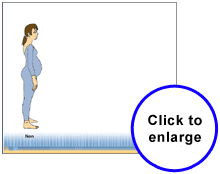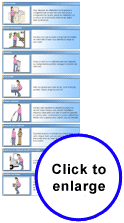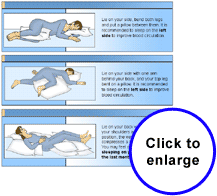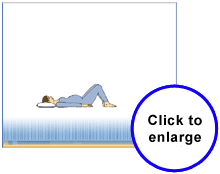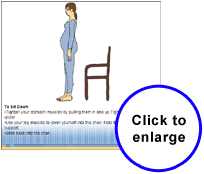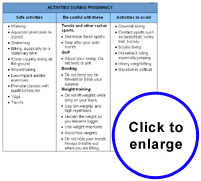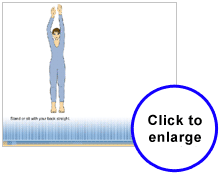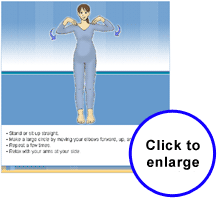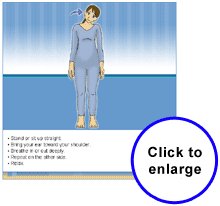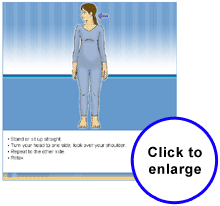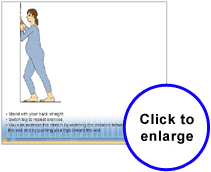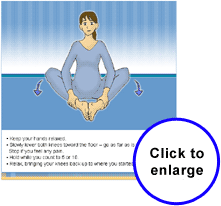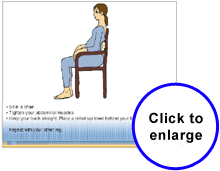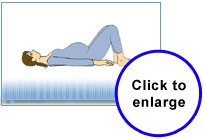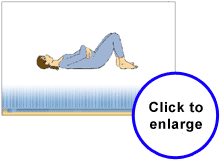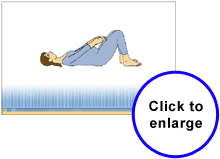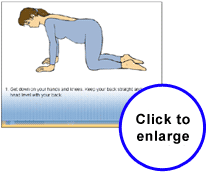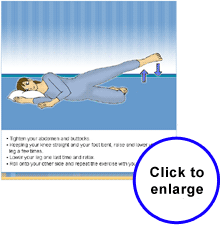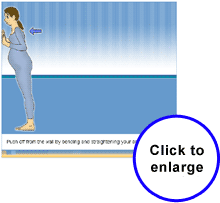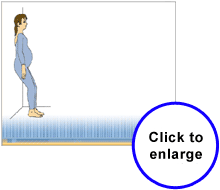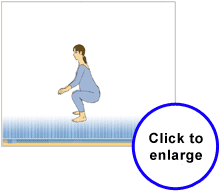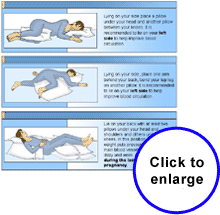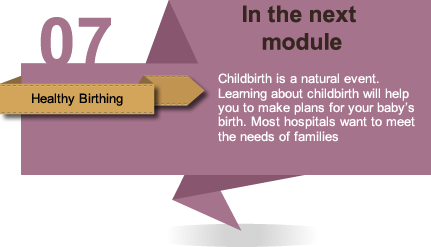Healthy Activity
INTRODUCTION
Active living means making some kind of physical activity part of your daily life. It means doing things which suit your schedule and are fun, healthy, and satisfying for you.
During your pregnancy, physical activities can help reduce stress, prevent backache, manage your weight, make labour and delivery easier, and prevent certain discomforts experienced during pregnancy. You will improve your general condition, have more energy, and feel alive if you remain active.
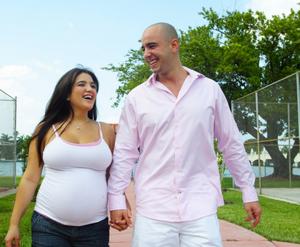
Unless you have medical reasons for not being physically active, you will be helping yourself and your baby by being active. If you have not been active in the past, talk with your health care provider, physiotherapist, or fitness instructor before beginning an exercise program. Whatever the case, start slowly and build at your own pace.
A. DAILY ACTIVE LIVING
As your size and shape change during pregnancy, you may find that ordinary positions such as standing and sitting seem uncomfortable and awkward. You will have to adjust your movements to allow for the changes in your body and make these everyday activities safer and more comfortable.

a. Posture
The key to comfort during your pregnancy is good posture. By standing correctly, you distribute the weight of your pregnancy without straining your back and abdominal muscles.
The following picture shows how you can improve your posture during your pregnancy.
Remember good posture when walking
Keep your back straight and your head up. Imagine that there is a rope attached to the top of your head, pulling you upward and straightening your spine.
Tips for comfortable standing
If you must stand for long periods, raise one foot on a stool or the rung of a chair. This will ease the tension on your back. When using a broom or vacuum, stand with one foot forward and knees bent. This will make it easier for you to shift your weight and turn.
b. Daily Back Care
Back pain is common during pregnancy. As your baby grows, your centre of gravity changes affecting your balance. Taking care of your back can be an everyday activity, now and after the birth of your baby.

1. Housework
Housework should be shared with the family members. If not already done, ask your partner or other family members to do their share daily. It is very important to take care of you at this time. Accept the help offered now and after the birth of the baby.
The following pictures offer advice which may help to prevent daily back pain.
2. Sleeping Position
While pregnant, you may have difficulty finding a comfortable position to sleep. Unfortunately, your regular positions may not be suitable.
It is best to avoid lying on your back after you are 16 weeks pregnant. The best position for sleeping during pregnancy is on your side, especially if you sleep on your left side because this position improves blood circulation.
Your mattress should be firm. Sleep in a way that does not put strain on your neck and back muscles. You may change position while you are sleeping.
Here are a few tips to sleep comfortably.
Avoid sleeping on your belly because it puts too much pressure on your neck and back.
3. Sitting Position
A rocking chair or good armchair will make sitting more comfortable.
The seat must be at the proper height so that your thighs rest comfortably when your feet are flat on the floor. It should be deep enough to support the length of your thighs but shallow enough to let your upper and lower back rest against the back of the chair.
The back should be high enough to support your shoulders. It is even better if it can support your head.
The armrests should be at the right height so that you can rest your arms comfortably when you are sitting straight.
If you do not have a comfortable rocking chair or armchair, you can make any chair more comfortable by using a pillow, footrests, or footstools for support.
Here are a few tips to adopt a good sitting position.
4. Changing Positions
As your baby grows during pregnancy, you may find it harder to change positions - for example, to get out of bed or to get up after exercising. Try to move slowly and carefully as you change position to help prevent muscle strain and dizziness.
The following animation demonstrates how to get out of bed.
The following animation demonstrates how to get up.
The following animation demonstrates how to sit in a chair and get back up.
c. Safe and Comfortable Activities
Physical activity is not dangerous and is recommended during your pregnancy. By being careful, you can do most of the things you enjoy.
Walking, dancing, biking, gardening, pushing a baby in a stroller or playing with children are examples of daily physical activities that can improve your general health.
If you are already active, try to remain active during your pregnancy. If you were not physically active before your pregnancy, you could begin during your pregnancy by walking, swimming, and doing prenatal exercises.
Moderation is the key. Listen to your body. If you feel pain, fatigue, or are abnormally out of breath, slow down or change activity.
The following table contains a list of activities that are safe, activities that are less safe, and activities to avoid during pregnancy.
B. A PROGRAM FOR AN ACTIVE PREGNANCY
Prenatal activity strengthens, relaxes, and increases the flexibility of your body muscles. All of these are important for a healthy pregnancy and delivery and a quick recovery.
These exercises are also recommended after the birth of your baby. They will help you return to your pre-pregnancy state and give you the energy you need to enjoy your newborn.
These exercises should be done as often as possible - everyday is ideal. Have fun doing your exercises. A friend or your young children can join you to do the exercises. You will start to feel the benefits sooner than you might think.
Here are a few tips to practice safe physical activities
CAUTION: After cardiovascular exercise, do not lie flat on your back or on your right side until your body has cooled down.
 |
Stop exercising and talk with your doctor if
|
a. Warm-up
Warming up prepares your body for exercising. Slow stretching will make you more flexible and prepare your muscles for increased activity.
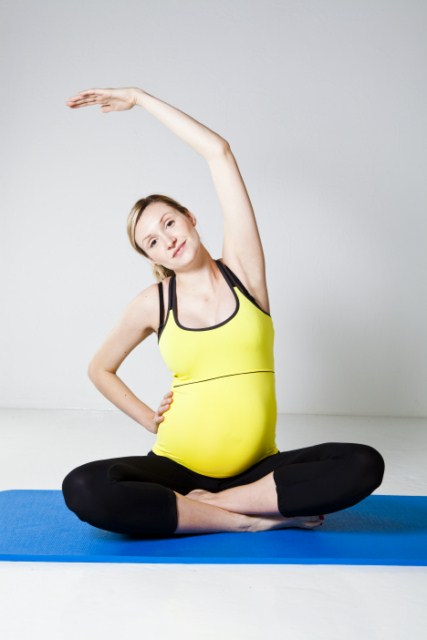
1. Alternate or Upward Arm Stretches
2. Elbow Circles
3. Neck Stretches
4. Head Rotation
5. Calf and Hip Stretch
6. Tailor Sitting
This exercise stretches the muscles situated on the inside of your legs.
CAUTION: When you are in this position, never use your hands or elbows to press your knees towards the floor. This could cause over-stretching and tearing in your pubic area.
This is how you can adopt the tailor sitting position.
7. Leg Stretching
b. Strengthening and Stretching Exercises
The exercises in this part of the program are designed to help your body adjust to pregnancy and get it ready for childbirth.
CAUTION: When doing these exercises, avoid lying on your back for more than 5 minutes without pillows under your head and shoulders.
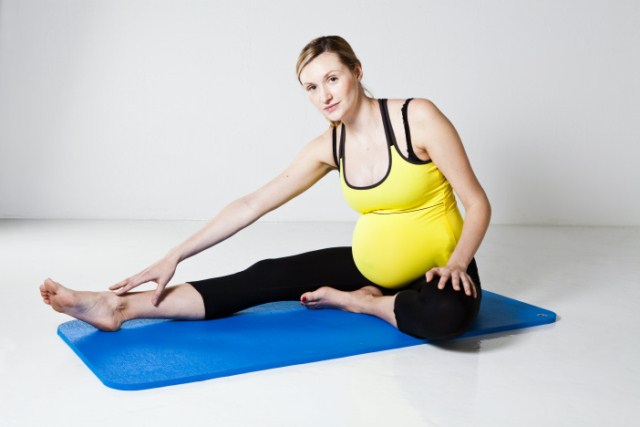
1. Pelvic Tilt
2. Basic Pelvic Floor Exercises
The next two exercises are designed to help you strengthen and control your pelvic floor muscles. Your pelvic floor is made up of the layer of muscles that is attached to your pubic bone in the front and your tailbone in the back.
During pregnancy you need strong pelvic floor muscles to support your uterus. During childbirth you need to be able to control these muscles, so you can relax them during the birth of your baby.
These exercises are often referred to as "hidden exercises" or "Kegel exercises". You can do these exercises anytime - when you brush your teeth, while watching TV, or standing in line at the grocery store. In fact, you can do these exercises anytime, anywhere, in any position - lying, sitting, or standing.
This is how the basic pelvic floor exercise is done.
This is how the elevator exercise is done.
3. Curl-ups
The exercises in this section are intended to help strengthen your abdominal muscles. Strong abdominal muscles will help you to be more comfortable now and will help you during labour and delivery.
Before you do any abdominal exercises, you need to check for abdominal muscle separation. This separation occurs at the central connecting seam of the abdominal muscles. It may be slight or very noticeable, and it happens to about one out of every three pregnant women. Ask a friend, your partner, health care provider, or prenatal educator to help you check this out.
 to check if you have an abdominal muscle separation.
to check if you have an abdominal muscle separation.
To do the following exercises later in pregnancy, you may want to put pillows under your upper back so you are lying on a slant. This will allow you to continue with your abdominal exercises and place less strain on your trunk.
To begin, this is how to do the curl-ups that will strengthen your abdominal muscles.
This is how to do the diagonal curl-ups - an exercise that strengthens your diagonal abdominal muscles.
CAUTION: Avoid this exercise if you have an abdominal muscle separation.
4. Pelvic Rock
5. Side-Lying Leg Lifts
6. Ankle Circles
7. Push-off
8. Imaginary Chair
9. Squatting
c. Cool-down
Just as warm-ups ease your body into exercise, cool-downs ease your body out. For your cool-down, repeat the warm-up exercises.
Here is the list of warm-up exercises that are also used for cool-down.
1. Alternate or Upward Arm Stretches
2. Elbow Circles
3. Neck Stretches
4. Head Rotation
5. Calf and Hip Stretch
6. Tailor Sitting
7. Leg Stretching
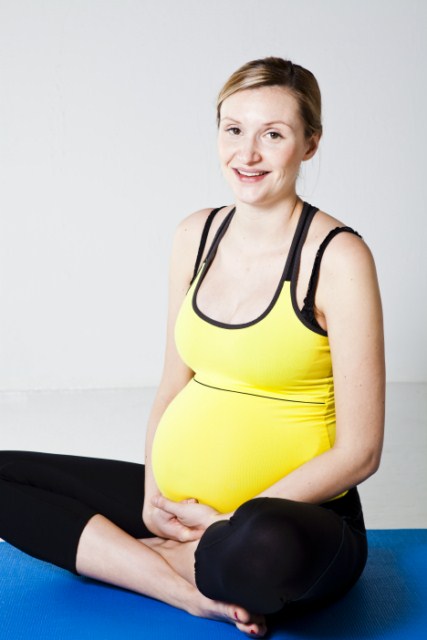
C. RELAXATION
Relaxation is a way of letting go. When you relax, you let go of the tension in your muscles and in your mind.
Relaxation helps save energy and creates a feeling of well-being. Learning relaxation techniques is one of the best ways to help make your labour and delivery easier.
The exercises found in this section correspond to only one relaxation technique. It is not the only one available. If you have a method that helps you to relax, use it.
When you practice relaxation:
- make sure that all parts of your body are supported and comfortable.
- let go of all muscle tension.
- clear your mind.
- breathe slowly and evenly.
Relaxation is a life skill. Learn to use it now, and you will find ways to use it during your pregnancy, delivery, and for the rest of your life.
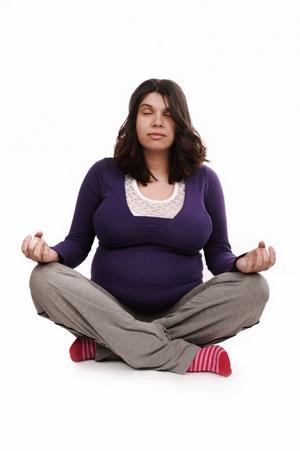
a. Comfortable Positions
Since you do not know which position will be best for you during labour, it is a good idea to practice several.
The only position to avoid is lying flat on your back. This is because the weight of your uterus presses on your blood vessels and can reduce the blood flow to you and your baby.
Here are a few suggestions to find a comfortable position.
b. Relaxing Moments
It can be helpful to have your labour partner check your muscles for tension while you are learning relaxation techniques. They can gently touch or lift parts of your body - for example an arm or a leg. If it is limp or relaxed, your partner puts it gently back on the pillow. If your arm or leg is tense, your partner massages or touches it gently until it relaxes. A warm, soft touch can be very relaxing. Many people find it easier to relax their muscles and to "let go" in response to a touch.
Breathe slowly and deeply while you learn to relax.
When you tighten your muscles, do not contract them too tightly. It is enough to feel them contract.
As you relax, think about letting go or releasing the tension in all your muscles.

c. Relaxing Step by Step
The purpose of this routine is to help you learn how to recognize and then release muscle tension. You do this by tightening and releasing your muscles one by one. Inhale to contract and exhale to relax.
You may start at your toes and work up to your face or start with your face and work your way down to your toes. Try it both ways and see which one is more relaxing for you.
Find a comfortable position in which all the parts of your body are supported and comfortable.
You may enjoy having your labour partner guide you through your relaxation with a calm and soothing voice. This will help you learn the routine and get you used to relaxing when you hear your labour partner's voice. This will be very reassuring when you are trying to relax during labour.
If you are alone and wish to exercise.
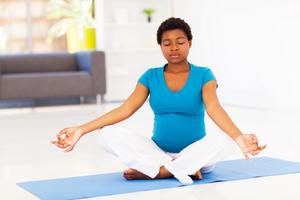
D. A POSTNATAL PROGRAM
Getting back in shape after childbirth requires postnatal exercises and the resumption of physical activities.
You can start doing postnatal exercises as soon as the baby is born even if you have had a Cesarean birth. When you return home, you can resume your prenatal routine. Start slowly and regain your strength gradually.

a. Postnatal Program
Postnatal exercises are just as important as prenatal exercises. Some help your body adjust to the changes brought on by the pregnancy and others help you to return to the pre-pregnant state.
Postnatal exercises will improve your circulation, speed up healing, and restore your muscle strength. Furthermore, postnatal exercises will help your bowels and bladder return to normal. You will recover your energy more quickly and feel better and more relaxed.
The following table summarizes the exercises that you can do during your first week back home. Refer to Section B "A Program for a Healthy Pregnancy" in this module for a more detailed description.
In your second week at home, add the rest of the stretching and strengthening exercises from your prenatal routine.
b. Resuming Physical Activities
It is important to slowly resume your physical activity routine. Start with walking or swimming. If you have had stitches, make sure that they are well healed and that all vaginal bleeding has stopped. Remember that moderation is the key. Listen to your body. If you have any pain or increased bleeding, stop and call your health care provider.

Talk with your health care provider before you return to a favourite sport or activity. Within eight weeks you should be able to participate fully in all your favourite activities.
c. Precautions after a Cesarean Birth
If you have had a Cesarean birth, you can and should begin your postnatal exercises while still in the hospital. When you return home, you can follow the same postnatal exercise program as other mothers with only one exception: omit all abdominal exercises such as curl-ups and diagonal curl-ups until three to six weeks after delivery.
CONCLUSION
Making healthy activity a part of your daily life is worth the effort. When you feel fit and healthy, you feel as though you can handle almost anything. The everyday discomforts and stresses of life seem easier to cope with.
Healthy activity is an important part of a healthy pregnancy. With a little effort and goodwill, you will be active and fit during your pregnancy and for your entire life.

